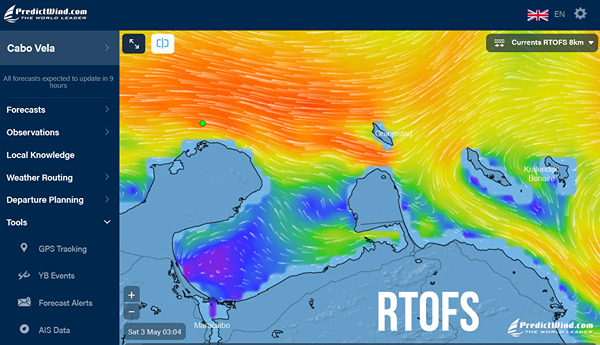Sailing from Santa Marta, Colombia to Aruba – An Uphill Battle
Attempting to sail from Santa Marta to Aruba is one of the more challenging passages in the southern Caribbean. On paper, it’s a short hop , roughly 260 nautical miles , but in practice, it’s a slog dead to windward in one of the most notorious stretches of water between Panama and the ABCs. The consistent easterly trade winds funnel along the South American coast, often accelerated by the Venturi effect between the Sierra Nevada mountains and the Caribbean Sea, creating near-constant 25 to 35-knot headwinds and steep, short-period seas.
This region is infamous for its confused, breaking waves and frequent gale warnings, especially between Santa Marta and Cabo de la Vela. The coastline offers few safe bailouts, and anchoring along the Guajira Peninsula is exposed and risky. Boats attempting this passage often experience slamming, gear fatigue, and crew exhaustion , especially monohulls beating into the trades.
The crux of the problem is not distance, but direction. You are heading almost due east into the prevailing conditions with limited leeway. Most cruisers either wait months for a slim weather window or opt for the longer but easier route , sailing downwind to the San Blas or Bocas del Toro, then heading north through the Windward Passage or looping up through Jamaica and the Dominican Republic before reaching the ABCs.
However, there are rare windows when a sail from Santa Marta to Aruba becomes feasible. These occur primarily during the transition periods between seasons , late May to early June or mid-October to early November. During these times, the trade winds temporarily weaken as the Intertropical Convergence Zone (ITCZ) shifts. Light easterlies or even westerly anomalies may occur for 24 to 72 hours. These brief windows are usually preceded by several days of stillness or light air and may be accompanied by unsettled weather or isolated squalls.
Successful passages during these times rely on careful weather routing. Services like PredictWind, Windy, and Chris Parker’s forecasts are invaluable. A viable window looks like 10-15 knots of E or ESE wind, with swell under 1.5 meters. Departing Santa Marta at the start of this lull is key , any delay risks getting caught as the trades reassert themselves.
Fuel range also becomes critical. Many skippers motor the bulk of the way in calm seas if lucky, but boats with limited tankage may need to carry jerrycans or consider a stop at Cabo de la Vela or Puerto Bolívar, though facilities are minimal and security concerns linger.
Ultimately, while it’s possible to sail from Santa Marta to Aruba, the prudent approach is to wait for the rare weather break , or reverse course entirely and head downwind. Going east in this region is a game of patience, timing, and preparedness. When it works, it’s satisfying. When it doesn’t, it’s punishing.
CURRENT CONDITIONS
WINDS
Tides and Currents
SWELL AND WAVES
The rare wildcard:
sailing from Santa Marta to Aruba in the lee of a hurricane or tropical system.
This scenario can open up a temporary “reverse flow” opportunity that otherwise doesn’t exist in this region, but it’s not for the faint of heart and should be approached with extreme caution.
What Happens in the Lee of a Hurricane
When a named system (tropical storm or hurricane) tracks northwest or westward above latitude 13°N—especially if it’s located north of the ABCs—there can be a dramatic disruption in the typical easterly trade winds. On the southwest quadrant of the storm (its “lee”), the wind can temporarily shift to the west, southwest, or even south for 24 to 72 hours.
In this rare configuration, the otherwise brutal headwinds from Santa Marta to Aruba can go soft or reverse. The sea state also tends to flatten out in this quadrant, especially if the storm is moving steadily away from you and not intensifying. This creates a narrow but viable corridor for a vessel to motor or close-reach along the coast and up toward Aruba with relative ease.
How Often Does This Happen?
Rarely. But it does happen, particularly during peak hurricane season (August to October), and even more so in El Niño years when storms tend to track farther north and curve earlier toward the Atlantic. The key is that the system must stay well north—ideally above 14°N—so that you’re not in its destructive path but close enough to experience the altered wind and pressure patterns.
Risks and Requirements
• Timing is everything. The window might last only 36 hours. Departing too late means running into building seas or the return of strong trades. Too early, and you could sail into a strengthening system.
• Weather routing is non-negotiable. You must monitor real-time GRIBs, satellite imagery, pressure gradients, and updates from NHC and regional meteorologists like Chris Parker. ( sponsor of the Ocean Posse get your discount )
• Fuel reserves matter. Even with reversed winds, motoring is often required, so full tanks and jerrycans are a must.
• Storm surge and swell. Even in the lee, long-period swells can wrap around and affect the coast. Anchorages and marinas in Aruba may still be impacted.
• Insurance may be void. Many policies have named-storm exclusions or require vessels to be out of the hurricane zone entirely.
Conclusion
Yes—sailing from Santa Marta to Aruba becomes temporarily viable in the lee of a tropical cyclone. The winds can clock to the west, the sea state may lay down, and for a brief time, it’s like the trades took a coffee break. But this is a tactical move requiring expert-level planning, flexible scheduling, and full situational awareness. It’s not a strategy to count on—just one to watch for when the charts and clouds align.
In other words: sometimes, it takes a hurricane to go east.
COLOMBIA TO ARUBA – THE IMPOSSIBLE UPWIND ROUTE – FIRST HAND ACCOUNT BELOW

WIND GUSTS

WAVES

WIND AND SWELL

CURRENTS
 2024-05-05 account from SV ROCHAMBEU
2024-05-05 account from SV ROCHAMBEU
Beyond devastated. That’s how we feel right now. It’s been a while since I’ve really documented our nomadic lifestyle. We have sailed from California, USA through Mexico, Costa Rica, the Pacific side of Panama, through the Panama Canal, the Caribbean side of Panama, through Colombia’s “pirate alley”, and two thirds the way to Aruba, actually into the waters of the Netherland Antilles. We met some of the most amazing adventurous people along the way who will forever be in our hearts. Some of them we met in California and others in Mexico. Some have split up but then we meet back up and call it “bungee-boating”. Some we will never see again. But yesterday morning we split up unexpectedly, heart wrenchingly. After motor sailing for 2 days and 2 nights in benign sea conditions, the weather took a drastic turn. Suddenly while on night watch, 25 knots of steady wind came out of the Atlantic and the seas starting pounding. By daylight we were feeling drained from a lack of sleep and our buddy boats had begun drifting away. We were still fine, all communicating on VHF radio, and eagerly waiting to just get through it for another 40-50 miles so that we could wake up to sunny Aruba and eat an anticipated Dutch breakfast. (You should’ve seen how excited Rolf grew a few nights ago when it dawned on him that we were going to sail to a country where people spoke his language and he could eat Dutch food again.) But then suddenly a new tie down strap for our dinghy snapped and blew away. Shit! Because we were bashing there was a lot of force and our dinghy davits were compromised, now damaged and weakened. We had another new strap and were able to secure the dinghy. Good. But, our solar arch is also partially sitting on top of the davits and now the dinghy and solar panels are at risk of just breaking off and going kerplunck into the angry ocean. If that weren’t enough, we had a 2 knot current that we were fighting against while feeling like we were riding a bucking bull. This slowed us down to a whopping 1 knot of “speed”. We were crawling and waves were crashing over our bows every now and then. Making life go from worse to miserable, our autopilot shutoff because it couldn’t keep up with the bashing. Conditions matter. And yesterday morning was a perfect example where with rough seas, strong current, and high wind (all on the nose) was a trifecta for poor motor performance and loss of the autopilot. So we had to make one of the toughest decisions ever – either steer by hand for 2 days and crawl to Aruba or turn back to Colombia. The main considerations were the stability of our dinghy davit system, our own safety & fatigue, and the comfort of our 14 year old dog, who was clearly suffering too. We bashed for an hour debating back & forth whether we could make it safely to Aruba or turn back. The problem was that the weather forecast now indicated the wind and sea state could persist for another couple of days. So with immense sadness we turned around. 😭😭😭 Now we’re alone, sailing back down the Colombian coast to Santa Marta, maybe even back to Cartagena. Next up, we have to still work our day jobs, which can be stressful and demanding at times while we figure out how to reinforce our dinghy davits and consider replacing our props. Really, I wish we could buy a bigger and more powerful boat with tons of horsepower for the 5-10% of the time we really need to motor hard from one amazing destination to another. But for now, I’m back to the night watch cruising solo. At least we’re comfortable with the wind and swells behind us and our sails are up.

